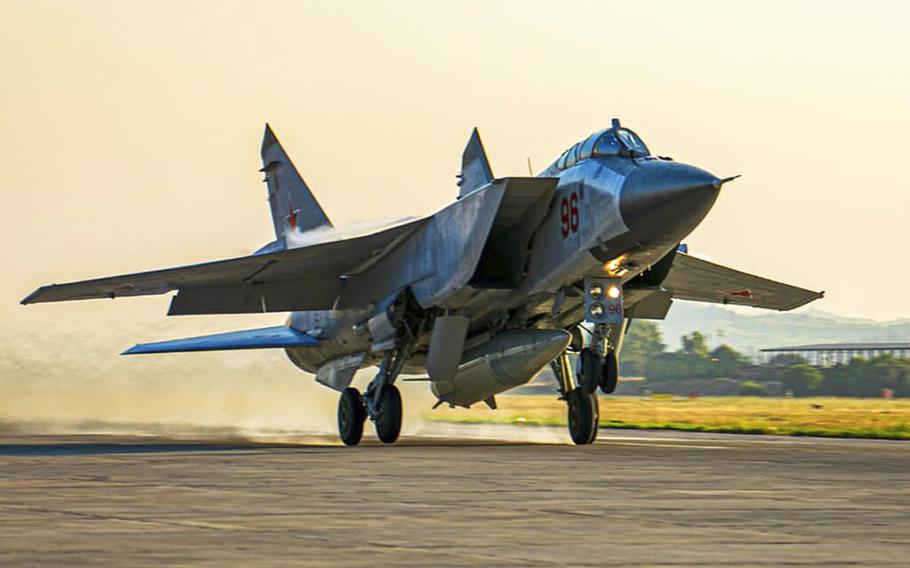
A Russian MiG-31 fighter jet carrying a Kinzhal missile takes off from the Hemeimeem air base in Syria on June 25, 2021. The Defense Ministry said three MiG-31 fighters with Kinzhal hypersonic missiles arrived Thursday, Aug. 18, 2022 at an air base in the Baltic Sea exclave. (Russian Defense Ministry)
Russia's invasion of Ukraine is at a near-operational standstill, with neither side currently able to launch an offensive that would materially affect the course of the conflict, according to an assessment from Western officials.
With both sides more conscious that they face a marathon rather than a sprint in a war already close to six months old, the tempo of the conflict has slowed, the officials said on condition of anonymity. They said the question now is whether Ukraine can generate a credible counter attack in the fall.
The assessment comes after a period in which officials in Kyiv had been talking up the possibility of an imminent counter offensive to retake Kherson, a river port city of some 290,000 that Russian forces captured as they swept through the south of the country at the start of the war.
The city is on the western bank of the massive Dnipro River, and has become increasingly precarious for Russian forces to defend and supply as Ukrainian artillery has destroyed available bridges.
That threat prompted Russian commanders to transfer forces from the main battlefields of the Donbas region, further east. Together with Ukrainian attacks on supply lines deep behind Russian lines, enabled by the arrival of US High Mobility Artillery Rocket Systems, or HIMARS, that weakened the Russian advance and reduced soaring Ukrainian casualties.
The Russian reinforcements to the southern front are digging in, however, making any immediate Ukrainian counter-offensive -- which typically would require three times as many attacking infantry as defenders to succeed -- more challenging and less likely.
Instead, independent military analysts see Ukraine as trying to grind down Russian supply lines until combat operations become untenable, a strategy dependent on a continued flow of long range artillery and ammunition from the US.
Already, the Russian campaign in Ukraine faces an acute shortage of munitions and is struggling to replace lost personnel, the Western officials said. Ukraine nevertheless continues to be outgunned in the artillery duels of the Donbas, while the city of Kharkiv has again come under heavy bombardment.
Russia's Black Sea Fleet is struggling to function, with half its naval aviation combat jets put out of use after explosions at the Saki airfield, in Crimea, on Aug. 9, according to the Western officials, adding that this has stymied Russia's ability to convincingly threaten an amphibious assault on Odesa.
Russia seen using Ukraine nuclear plant as shield for troops
A series of recent attacks by Ukraine on air bases in Crimea, which President Vladimir Putin annexed in 2014, show that Ukrainian forces are having a real impact behind Russian lines, hitting supply lines for combat units at the front, according to the Western officials, in addition to having a psychological effect on Russian leadership. The officials did not provide evidence of how they reached that conclusion.
The officials said they were also closely watching events at the Zaporizhzhia nuclear power plant in southern Ukraine. Bloomberg reported on Friday that Russia is likely using the plant to shield its troops and equipment, undermining the safety of its operations, according to European intelligence officials.
The Western officials saw the primary risk to the plant as its disconnection from the power grid, rather than shelling. Without a power connection, the plant would be forced to rely on diesel generators to keep the cooling systems for the plant's nuclear reactors operating.
The plant is Europe's largest, but the generators are intact and a workforce is in place to mitigate this risk, according to the officials.